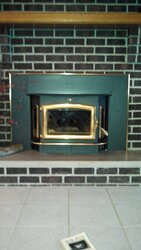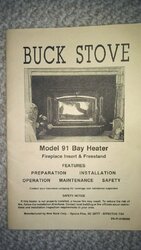A friend of ours had this Buck Model 91 Bay insert, pictured. I know little about catalytic stoves (except what I've read here). So I have some questions. The house they bought has been empty a couple or more years but in perfect condition and well kept. I suggested they have a chimney sweep inspect the system before trying it out, which they did. The fella advised them to get a fireplace grate (?!). Right away I've got to question the guy, but again, I know nothing about this type stove. Well, when I went over there today, sure enough they tried the grate ..... can't even really load wood in it due to height problems. Anyway I'll assume the wood should be placed directly on the bottom of the stove like my Lopi. That's question #1. I've been told the reason is because you'd get too much air to the wood when elevated.
I've read the owners manual and it doesn't seem that much different than the way I light mine with the bypass damper open except that the temp needs to hit at least 700 before closing the bypass to route it through the cat (I don't have a cat, just secondaries). That's question #2 - just close bypass after 700 degrees? The book says to expect temps over 1,000 when the cat is fired off good. I see a plate in the inside top of the stove with four bolts holding it up there. Question #3: Is this how to get to the cat? Should I drop this down and check things out? What do I look for? Question #4: How do you clean the cat? Think I've read somewhere that a an air hose can damage it. Hopefully removing the plate will let me put a light and mirror up there to look into the chimney for some piece of mind.
So, I'm planning to take them some of my trusted/seasoned wood and get them going for a few evening fires. I'll use my favorite "torch" method to get the first one going and recommend the Supercedars route for these folks as they get into the program. Their Buck stove looks to be built very well and it's in a large living area suited perfectly for a wood stove. The one fire they tried last week didn't pan out too well (likely wet wood and no experience)
Just thought of another question. I see no firebrick in this thing. Are they missing or does it just not run on the "insulated box" principle to raise the inside temps?
Thanks in advance for the advice.
I've read the owners manual and it doesn't seem that much different than the way I light mine with the bypass damper open except that the temp needs to hit at least 700 before closing the bypass to route it through the cat (I don't have a cat, just secondaries). That's question #2 - just close bypass after 700 degrees? The book says to expect temps over 1,000 when the cat is fired off good. I see a plate in the inside top of the stove with four bolts holding it up there. Question #3: Is this how to get to the cat? Should I drop this down and check things out? What do I look for? Question #4: How do you clean the cat? Think I've read somewhere that a an air hose can damage it. Hopefully removing the plate will let me put a light and mirror up there to look into the chimney for some piece of mind.
So, I'm planning to take them some of my trusted/seasoned wood and get them going for a few evening fires. I'll use my favorite "torch" method to get the first one going and recommend the Supercedars route for these folks as they get into the program. Their Buck stove looks to be built very well and it's in a large living area suited perfectly for a wood stove. The one fire they tried last week didn't pan out too well (likely wet wood and no experience)
Just thought of another question. I see no firebrick in this thing. Are they missing or does it just not run on the "insulated box" principle to raise the inside temps?
Thanks in advance for the advice.





 If the combustor doesn't work, you can try simmering it out in a vinegar/water solution before spending almost $300 on a new one. If you remove the combustor, you need a new interam gasket and cat housing-to-stove gasket.
If the combustor doesn't work, you can try simmering it out in a vinegar/water solution before spending almost $300 on a new one. If you remove the combustor, you need a new interam gasket and cat housing-to-stove gasket.
